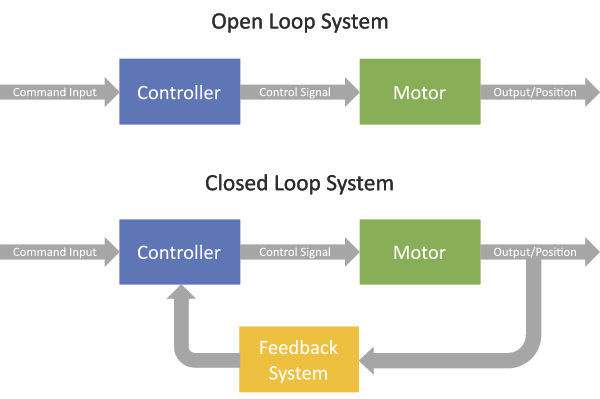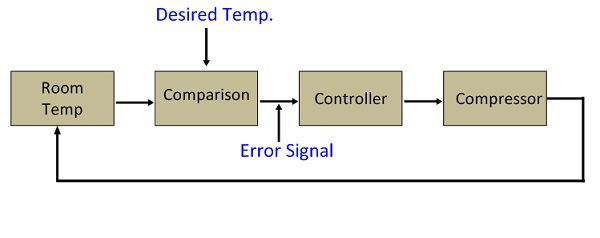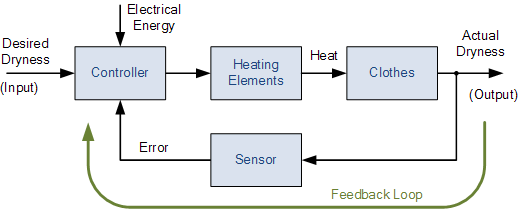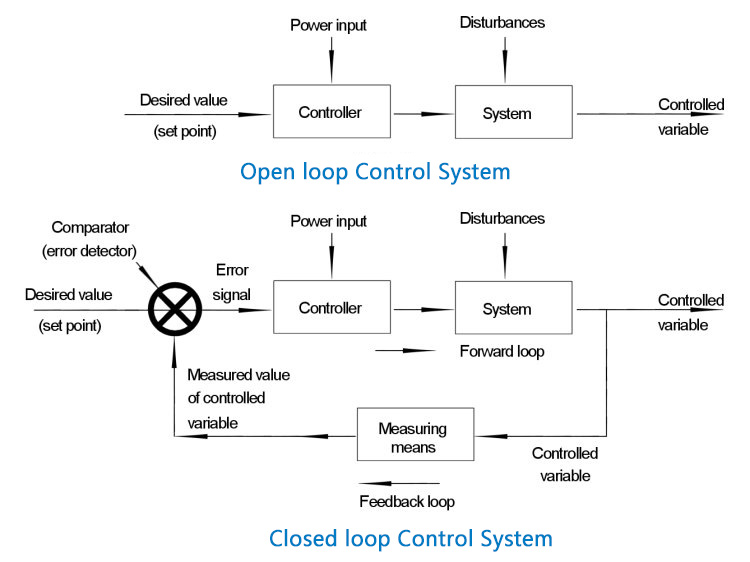
This article will introduce the meaning of closed loop control system and open loop control system in detail, and introduce multiple closed loop system examples and open loop system examples to help you understand them. By reading our article you will learn about the advantages, disadvantages and differences between open and closed loop systems.
Catalog
1. What is an Open Loop Control System?
2. Advantages of Open Loop Control System
3. Disadvantages of Open Loop Control System
4. What is a Closed Loop Control System?
5. Advantages of Closed Loop Control System
6. Disadvantages of Closed Loop Control System
7. Closed loop vs Open loop Control System
8. Conclusion
What is an Open Loop Control System?
Open-loop control system, also known as non-feedback system, refers to a control process in which there is only forward action but no reverse connection between the control device and the controlled object. In this type of system, the input signal is not affected by the output signal.

Figure 1: Open Loop Control System Block Diagram
An open loop control system operates on a set of predefined instructions or conditions without utilizing feedback from its output to adjust its actions. This means that the control action is initiated and conducted based on initial settings, without any subsequent modifications based on how the output compares to the desired outcome. Essentially, once an open-loop system is set in motion, it continues its operation according to the preset parameters, regardless of any discrepancies between the actual output and what was intended.
Open loop system examples
For a typical bread toaster, you set the toasting level using a control knob. This setting determines how long the toaster operates or how much heat is applied. However, the toaster doesn't measure the actual level of toasting and adjust its operation accordingly. Once it's set, it runs its course without any feedback. If the toast isn't to your liking (either underdone or overdone), the toaster has no way of knowing and adjusting its operation in the future; you would have to manually change the settings for the next use.

Open loop bread machine control system block diagram
In an open-loop control system, like this example, there is no feedback mechanism that adjusts the toasting time based on the color or crispness of the toast. The system does not adjust itself in response to the actual output. If the toast does not come out as desired, the user must manually adjust the time control knob for future attempts, as the system itself does not correct any discrepancies between the desired and actual outputs.
Examples of open loop control systems in life include water pump control systems, household curtain automatic control systems, automatic voice control devices for corridors, swimming pool timing water filling control systems, traffic light timing control systems at intersections, park music fountain automatic control systems, automatic Flag raising control system, hotel fire automatic alarm system, etc.
Advantages of Open Loop Control System
Open-loop systems are generally simpler in design because they don't require feedback components or complex algorithms to adjust outputs based on feedback.
Due to their simplicity, open-loop systems tend to be less expensive than closed loop systems both in terms of initial cost and maintenance.
Since there's no feedback loop, these systems are immune to problems like oscillations or instability that can sometimes occur in poorly designed closed-loop control systems.
Open loop controllers respond quickly since they do not wait for error signals as seen in closed loop system which might delay response time due to processing of the feedback signal.
Since an open loop system operates on predefined inputs without considering output changes, its behavior is very predictable if all conditions remain constant and within design parameters.
In cases where high precision isn't necessary (for example, controlling a toaster or a hair dryer), an open-loop system works perfectly well and is more economical.
Disadvantages of Open Loop Control System
Open-loop control systems, while simpler and often less expensive than closed-loop systems, do have several potential disadvantages:
Open-loop systems follow pre-set instructions without taking into account actual output values. This means they can't automatically rectify discrepancies between desired and actual results.
Open-loop systems lack feedback mechanisms, making them unable to self-adjust when there are changes or disturbances in conditions, which could lead to potential inaccuracies or inefficiencies.
Without a mechanism for self-correction via feedback, these systems have heightened susceptibility to errors triggered by external disruptions or environmental variations.
Given their lack of automatic adjustment capabilities through feedback loops, open-loop systems require meticulous initial calibration and may necessitate regular manual adjustments over time for precise operation.
For sophisticated processes where pinpoint accuracy is crucial (such as maintaining exact temperature levels), an open loop control system may not be sufficient due its inability to dynamically modify its behavior based on real-time outputs.
As components wear out over time and their characteristics evolve, performance drifts might occur since there's no inherent self-correcting mechanism like with closed loop controls.
What is a Closed Loop System?
A closed-loop control system, also known as a feedback control system, dynamically adjusts its operation based on feedback from its output. This means the system continuously monitors its output, compares it to the desired outcome, and adjusts its inputs accordingly to minimize any discrepancies. This feedback loop allows the system to self-correct and adapt to changes in external conditions or to its own performance over time, enhancing precision and reliability.

Figure 2: Closed Loop Control System block diagram
Key components of a closed-loop control system include:
Sensor: It measures the output of the system and provides the data needed for feedback.
Controller: It compares the actual output with the desired output (setpoint) and decides on the action required to correct any difference.
Actuator: It executes the corrective actions as determined by the controller to drive the system towards its setpoint.
As shown in Figure 2, the input signal is compared with the feedback signal from the feedback element to generate an error signal, which is processed by the controller to drive the actuator. The output of the actuator passes through the feedback element to form a feedback signal, which is returned to the comparator to complete the closed loop. The ultimate goal is to make the output signal follow the input signal.
Closed loop control system examples
Below we will list several examples of closed loop control systems to help you understand what a closed loop control system is.
Closed loop system example 1:

Air conditioning thermostat closed loop system block diagram
Thermostats in HVAC Systems: These systems measure the temperature of a room and compare it with the desired temperature. If the actual temperature deviates from the set temperature, the system adjusts the heating or cooling output to bring the room temperature back to the desired level.
Closed loop system example 2:
Cruise Control in Vehicles: When activated, cruise control maintains a vehicle's speed at a set value. If external factors, such as uphill or downhill terrain, cause the vehicle to deviate from this set speed, the system automatically adjusts the throttle to return the vehicle to the set speed.
Closed loop system example 3:
Automated Insulin Pumps for Diabetics: These devices continuously monitor glucose levels in the bloodstream and administer insulin as needed to maintain blood sugar at a target level. The pump adjusts insulin delivery in response to fluctuations in glucose levels, providing a dynamic, real-time response to the user's needs.
Closed loop system example 4:

Closed-loop clothes dryer controller schematic block diagram
The working principle diagram of the closed-loop clothes dryer is shown in Figure 5. The system takes the desired dryness as input, and the controller receives the input and drives the heating element, which generates heat to dry the laundry. The sensor detects the actual dryness and compares it with the desired dryness, and the error signal is fed back to the controller to adjust the heating amount to achieve the desired dryness. This process creates a feedback loop.
Advantages of Closed Loop Control System
Closed-loop control systems, also known as feedback control systems, have several advantages that make them suitable for a variety of applications:
Due to their ability to self-correct in real-time using feedback from the system's output, closed-loop systems can maintain very accurate control.
Closed-loop control systems are capable of adapting to changes in the environment or system parameters because they continuously monitor and adjust based on the output.
As components wear out over time and their characteristics change, closed-loop controls can continue to provide stable operation due to their inherent self-correcting mechanism.
Closed loop controllers are less affected by noise or other external disturbances since any impact on the output is corrected by adjusting inputs via feedback loops.
For intricate processes where precision is crucial (like maintaining an exact temperature level), a closed loop control system may be more effective due its ability to dynamically modify its behavior based on real-time outputs.
Disadvantages of Closed Loop Control System
While closed-loop control systems offer many advantages, they also come with certain disadvantages:
Closed-loop systems are generally more complex than open-loop systems due to the need for feedback mechanisms and error correction algorithms.
Closed loop Control systems tend to be more expensive, both in terms of initial setup cost and maintenance. The components needed for sensing, processing feedback signals, and adjusting system parameters can add up quickly.
Any issues in the feedback path such as sensor failures or signal transmission errors could lead to poor performance or even make the closed loop system unstable.
Closed-loop control system has slow response time. In some cases, waiting for an error signal before making adjustments might result in slower response times compared with open loop controls which act directly on input commands without waiting for any feedback.
Closed loop vs Open loop Control System
The following table aims to provide a clearer distinction between open loop and closed loop control systems by comparing them across various important attributes, helping to understand their fundamental differences, advantages, and limitations.

Open Loop versus Closed Loop| Comparison Basis | Open-Loop Control System | Closed-Loop Control System |
|---|
| Structure | The open loop system has no testing equipment and has a simple structure, but the selected components must strictly ensure quality requirements. | The closed loop system has the ability to suppress interference, is insensitive to changes in component characteristics, and can improve the response characteristics of the system. |
| Definition | A system where control action is not affected by output. | A system where output depends on control action with a feedback path. |
| Alternative Names | Non-feedback system. | Feedback system. |
| Main Components | Controller and actuators or processes. | Controller, actuators or processes, feedback elements, and error detector (comparator). |
| Design Complexity | Simple design and construction. | More complex design and construction. |
| Reliability | Less reliable. | More reliable. |
| Accuracy | Dependent on calibration; may be lower. | Generally more accurate due to feedback. |
| Stability | Strong stability; constant output. | Relatively lower stability due to dependence on varying inputs and conditions. |
| Response | Faster due to no output measurement and feedback. | Slower due to the presence of feedback and processing it for output adjustment. |
| Calibration | Challenging due to lack of feedback. | Easier due to feedback systems which allow for constant adjustments. |
| System Interference | More susceptible to disturbances since there is no correction mechanism. | Less affected due to feedback's ability to correct disturbances. |
| Linearity | Can exhibit non-linearity due to a lack of adaptive response to changes in conditions. | Tends to be more linear as feedback can adjust the system to maintain desired performance. |
| Typical Examples | Traffic lights, automatic washing machines, immersion heaters, TV remotes. | Air conditioners, temperature control systems, speed and pressure control systems, refrigerators, toasters. |
Open Loop vs Closed Loop: Working Principle
Open-loop control systems cannot detect errors and cannot correct them. The control accuracy and interference suppression performance are relatively poor, and it is very sensitive to changes in system parameters. Therefore, it is generally only used in some situations where external influences cannot be considered, or the inertia is small, or the accuracy requirements are not high.
The advantage of closed-loop control is that it gives full play to the important role of feedback, eliminates unpredictable or uncertain factors, and makes corrective actions more accurate and powerful. But it lacks the preventive nature of open-loop control. Only take corrective measures if adverse consequences occur during the control process. Therefore, it is generally widely used in occasions with relatively high requirements on the external environment and high precision.
Open loop vs Closed loop: Structure and composition
The open loop system has no testing equipment and is simple in composition, but the selected components must strictly ensure quality requirements. The closed loop system has the ability to suppress interference, is insensitive to changes in component characteristics, and can improve the response characteristics of the system.
Closed loop vs Open loop: Stability
The stability of open loop control systems is relatively easy to solve. The introduction of feedback loops in closed-loop systems increases the complexity of the system.
Conclusion
The fundamental difference between open loop and closed loop control systems lies in the presence or absence of a feedback mechanism. An open loop system operates based on preset inputs, without considering the output results, lacking self-adjustment capabilities. In contrast, a closed loop system monitors its output and feeds back this information to adjust its input accordingly. This allows it to more accurately achieve desired outcomes and counteract potential disturbances or errors.
Frequently Asked Questions
1. What are the 10 common examples of closed-loop control systems?
Common examples of 10 closed-loop control systems include Thermostat-controlled Heating System, Cruise Control in Cars, Automatic Electric Iron, Air Conditioning System, Inverters in Solar Power Systems, Autopilot in Aircrafts, Insulin Pumps for Diabetics, Robotic Arm Positioning Systems, Servo Motors, Active Noise-Canceling Headphones.
2. What are the 10 common examples of open-loop control systems?
10 examples of common open loop control systems include: Manual Washing Machine, Toaster, Electric Hand Dryer in Public Restrooms, Automatic Door at Supermarkets, Traffic Lights System, Microwave Oven Timer, Sprinkler System, Timer-based Drip Irrigation System, Alarm Clock, Light Switches.
3. Which is the best example of a closed system?
A thermostat-controlled heating/cooling system monitors room temperature continuously and compares it with desired setpoint temperature (the input). If there's any discrepancy between actual room temperature and setpoint temperature (error), it either turns on/off or modulates heating/cooling devices accordingly until actual room temp matches with setpoint temp - thus demonstrating key features of closed loop control: continuous monitoring (feedback), comparison with desired state(set-point), error detection & correction(action).
4. Which is the best example of a open system?
A classic example of this is a traffic light. The traffic light operates on a fixed schedule: green, then yellow, then red, and back again without any input about whether there are cars waiting or not.
5. Does the comparator use an open loop or closed loop system?
A comparator, a device that compares two voltages or currents and outputs a digital signal indicating which is larger, operates as an open-loop system because it does not inherently include feedback.
However, while comparators themselves function in an open-loop manner, they can be integral components within larger closed-loop systems. For example, in a thermostat-controlled heating/cooling system—a classic closed-loop control system—a comparator might be used to compare the current temperature with the desired set-point temperature. The output from this comparison would then inform whether to activate or modulate heating/cooling devices—thus forming part of the overall feedback mechanism.
6. Is the operational amplifier(Op amp) an open loop or closed loop system?
An operational amplifier (Op-Amp) itself is an open-loop system, as it amplifies the voltage difference between its two inputs without any feedback.
However, in practical applications, Op-Amps are often used in a closed-loop configuration by adding external feedback loops. This helps to control the gain and stabilize the operation of the circuit. Two common configurations are:
Inverting Amplifier: Here negative feedback is used where output is fed back into the inverting (-) input.
Non-Inverting Amplifier: Here positive feedback is used where output is fed back into non-inverting (+) input.